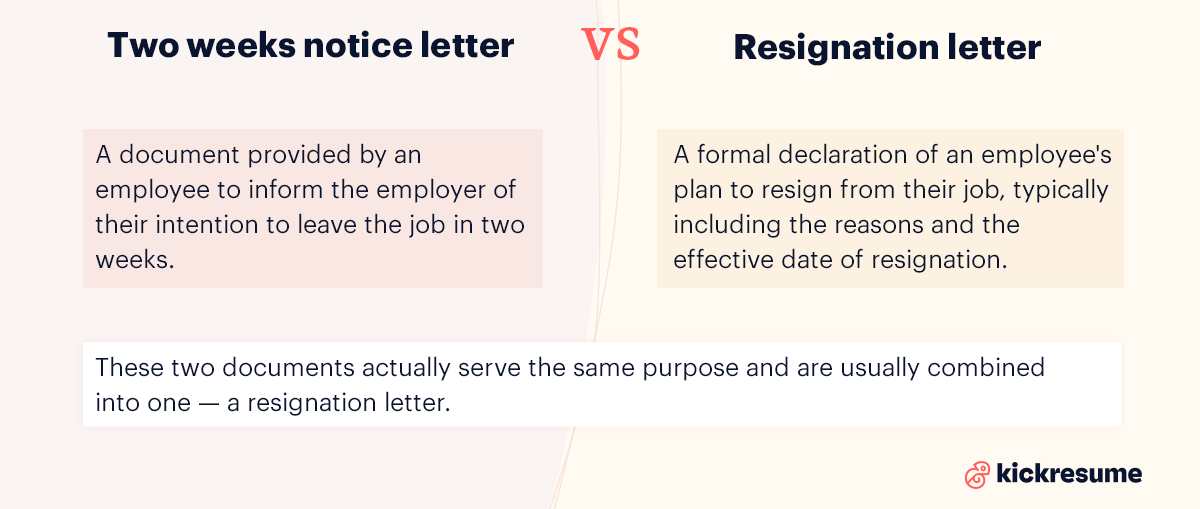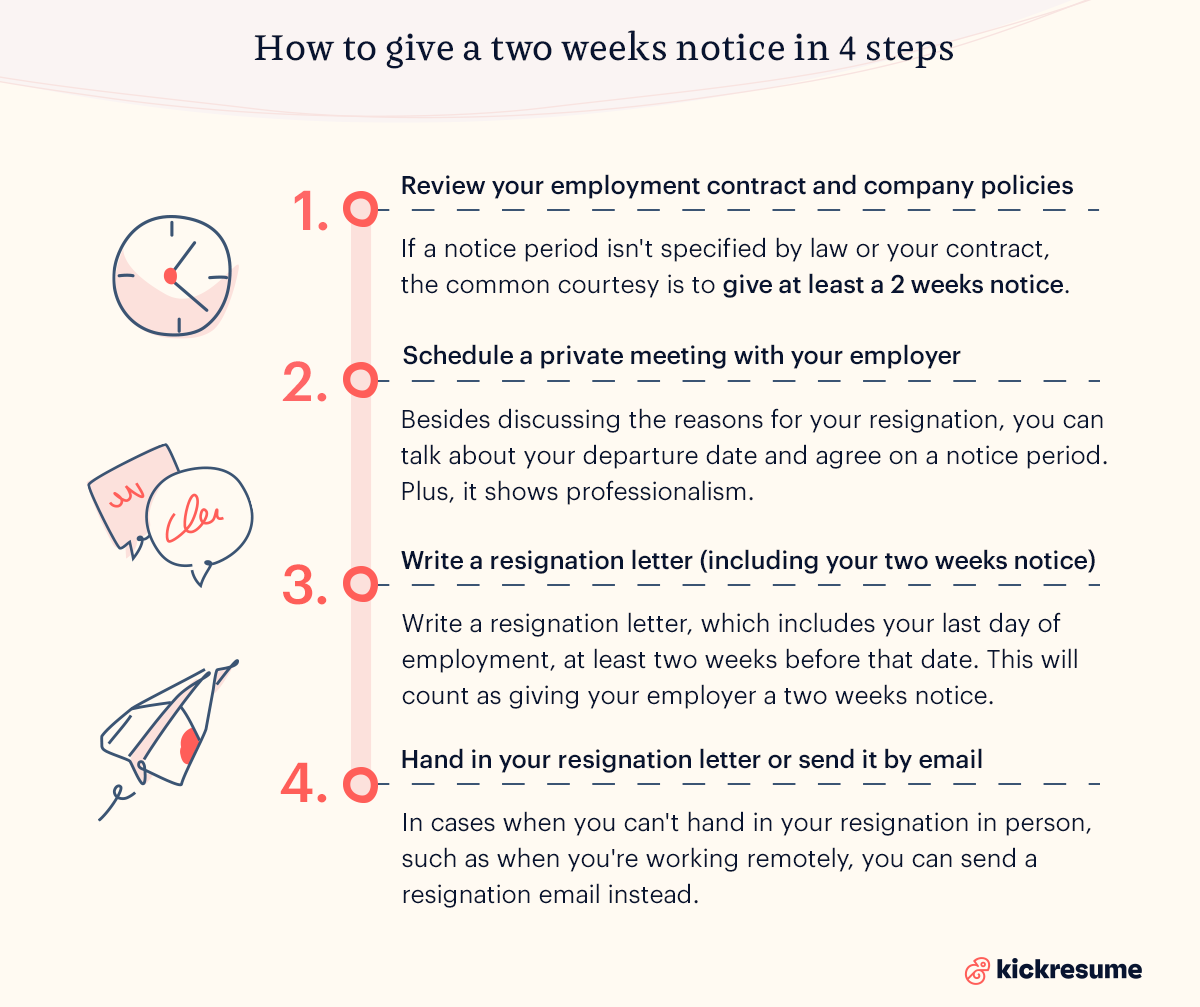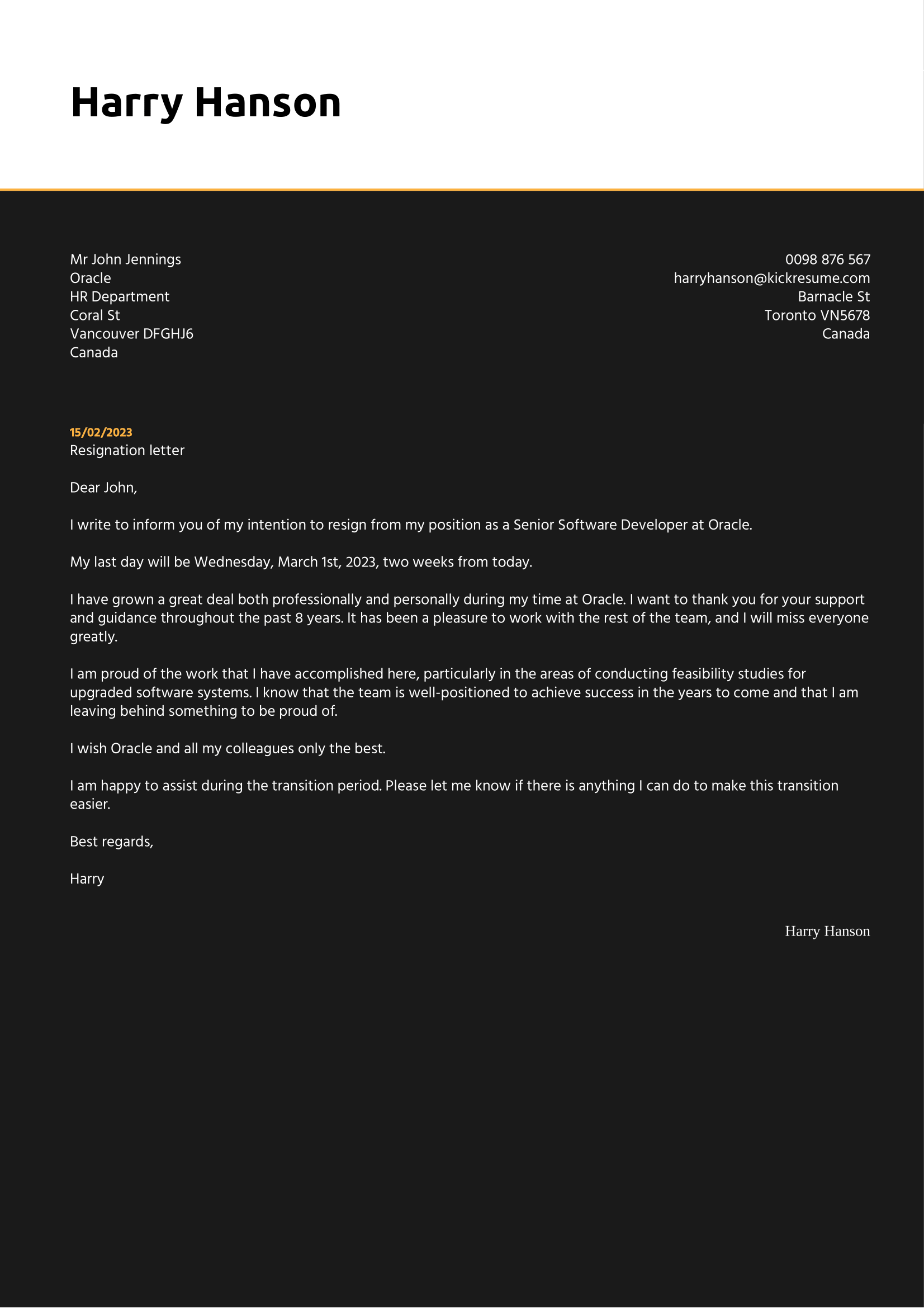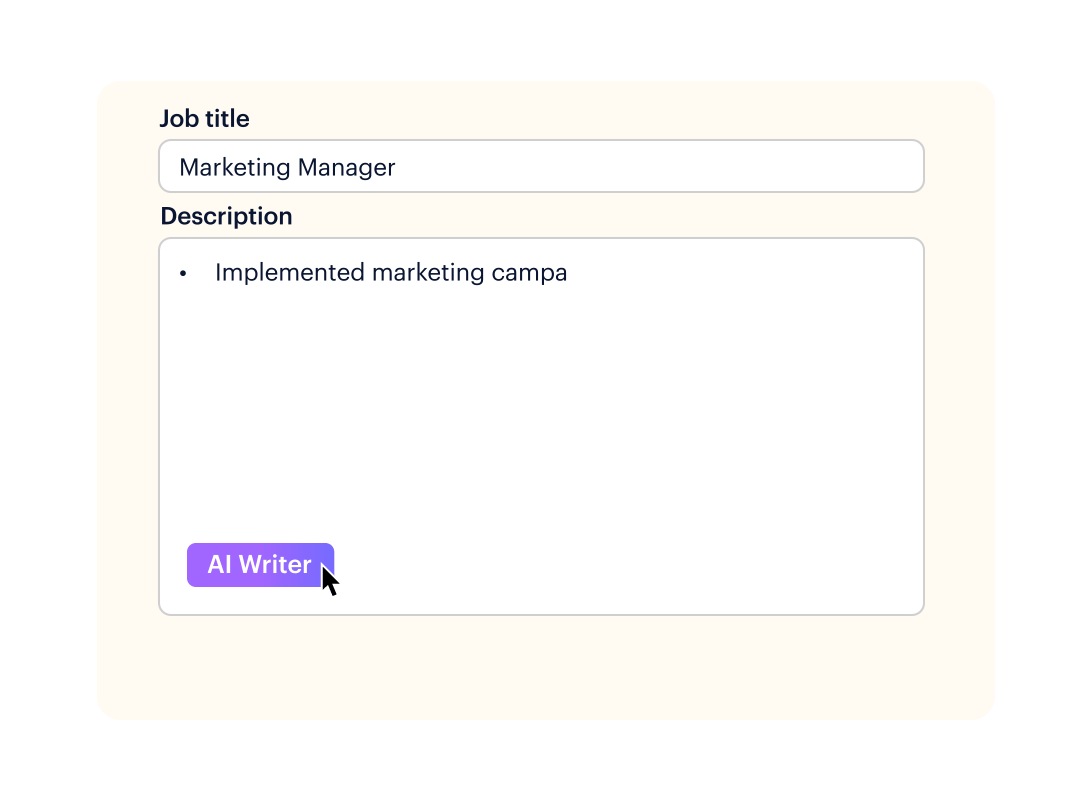Leaving a job can be a challenging and emotional experience, but it's essential to quit your job the right way.
It's not as simple as not showing up at work or telling your boss, “I quit.”
In reality, there are several things you should do to ensure a professional resignation process.
And learning how to give a two weeks notice is definitely one of them.
It's one of the most crucial aspects of resigning from a job, which ensures a smooth transition for both you and your employer.
In this article, we'll go over the concept of the two weeks' notice, explore if it differs from a resignation letter, and look at what are some of the legal obligations tied to notice periods.
Finally, we provide you with a step-by-step guide on how to give a two weeks notice and show you a two weeks notice resignation letter example and template.
What is a two weeks notice?
A two weeks notice is a notification given by an employee to their employer that they plan to leave their job in two weeks' time.
Its purpose is to provide a reasonable period for the employer to find a replacement and ensure a smooth transition of responsibilities.
The notice period is a period of time starting from the day you hand in your resignation letter until your last day at the job.
Notice periods can vary significantly across the globe:
- Some countries have legally binding notice periods for employees and employers. It can vary from a few weeks to several months. In these cases, the length of the notice period is typically specified in the employment contract and must be adhered to by both parties.
- In the United States, however, the situation is different. There's no legally binding notice period required for either the employer or the employee to terminate the working relationship. That being said, it's common courtesy that you provide a two weeks notice at least.
This means that, technically, an employee in the US can leave their job without giving any notice, and an employer can terminate an employee without providing any warning or notice, unless there is a specific contract or collective bargaining agreement in place that states otherwise.
Despite the lack of legal requirements for a notice period in the US, it has become a common courtesy for employees to provide at least a two weeks' notice when resigning from their job.
Why should you give two weeks notice?
Giving a two weeks' notice when resigning from a job is a widely accepted practice, and there are several compelling reasons for it being this way.
Here are 4 reasons why giving a two weeks' notice is a must when quitting a job:
- Professionalism. Providing a two weeks' notice demonstrates your professionalism and commitment to responsibly handling the end of your employment. It shows that you respect your employer and the working relationship you've built together.
- Maintaining a positive reputation in your industry. A positive reputation can lead to more job opportunities, better networking connections, and a stronger professional standing within your industry.
- Leaving on good terms for future networking or references. When you quit your job professionally, you increase the likelihood of your employer providing a positive reference for you in the future. Good references can significantly impact your chances of securing future job opportunities and advancing in your career.
- Allowing your employer time to find a replacement. A two weeks' notice provides your employer with sufficient time to search for and potentially hire a new employee. This helps minimize disruptions in the workplace and ensures a smoother transition for your team and the company as a whole.
In summary, giving a two weeks notice is an essential part of resigning from a job professionally and responsibly. So, don't doubt it; just do it.

Two weeks notice letter vs. resignation letter
When it comes to leaving a job, there might be some confusion surrounding the terms two weeks notice letter and resignation letter.
While they theoretically can be two different documents, they actually serve the same purpose. This is why they're usually combined into one document— a resignation letter.
- Two weeks notice letter: is a document provided by an employee to inform the employer of their intention to leave the job in two weeks. It's quite uncommon to have it as a separate document.
- Resignation letter: is a formal declaration of an employee's plan to resign from their position, typically including the reasons behind the decision and the effective date of resignation.
Combining both the two weeks notice letter and the resignation letter into one document is a common practice, as it efficiently conveys all the necessary information to the employer.
This single document — the resignation letter — should then include several key components:
- Your and the recipient's credentials
- Time and date of writing
- Resignation statement
- The final day of employment, which is at least two weeks from the date of writing. This then counts as giving your two weeks notice.
- Reasoning, gratitude, or offering of help (optional)
- Signature
In some cases, an employer might request separate documents for the two weeks notice letter and the resignation letter. This could be due to company policies or for record-keeping purposes.
However, unless specified by the employer, it's generally more practical and efficient to include all the relevant information in one comprehensive resignation letter.
Resignation letter with two weeks notice template
[Your name], [Your phone number], [Your email]
[Date of writing]
[Name of recipient]
[Company name], [Company address]
Dear [Name of recipient],
Please accept this letter as my formal resignation from [Company name] from my position as a [your position]. My last day will be [day of the week], [month, day, year], two weeks from today.
I would like to thank [Company name] for providing me with the opportunity to grow and develop my career during the last [number] years. I wish [Company name] and my team the best.
In the next two weeks, I will complete [the tasks you have left] and, as discussed, will assist you in the process of finding someone to take over my responsibilities.
Please let me know if there is anything else I can do.
[Your name]
[Signature]
How to give two weeks notice: Quick step-by-step guide
When the time comes to leave your job, it's essential to handle the process professionally — which means not forgetting to give a two weeks notice.
If you aren't sure how to do so, this chapter provides a quick 4-step guide on how to write a two weeks notice:

1. Review your employment contract and company policies
Before taking any action, carefully review your employment contract and your company's policies regarding resignation and notice periods.
Ensure you understand any requirements or guidelines that may apply to your situation.
If a notice period isn't specified by law or your contract, the common courtesy is to give at least a 2 weeks notice.
2. Schedule a private meeting with your employer
Select a moment when your boss or supervisor is less overwhelmed with work and request a one-on-one meeting to discuss your resignation.
Although telling your boss you're quitting is uncomfortable, it demonstrates professionalism and ensures they don't hear it from other people.
Apart from explaining why you're resigning, you can also discuss when you plan to do so, and find a consensus regarding the notice period.
3. Write a resignation letter (including your two weeks' notice)
Next, it's time to prepare a professional resignation letter that contains all key components, including your two weeks' notice.
Here's what to include in a resignation letter:
- Your credentials at the top
- The date of writing
- Recipient's address
- Resignation statement
- The final day of employment
- Reasoning, gratitude, and offering of help
- Signature
Make sure the date of writing and the final day of employment are at least two weeks apart. This will count as giving your employer a 2 weeks notice and will ensure a smooth transition period.
Here's an example of a resignation letter with two weeks notice (check the second sentence):

And, if you're not a fan of writing it yourself, you can let AI write a resignation for you and have it ready at hand in a few seconds.
4. Hand in your resignation letter or send it by email
Once your resignation letter is finalized, you need to hand it in to seal the deal. It's always best to do so in person. However, that's not always possible.
In cases when you can't hand in your resignation in person, such as when you're working remotely, you can send a resignation email instead.
A resignation email is simply a shorter version of a resignation letter sent by email.
This provides a written record of your resignation and ensures that all the necessary information has been communicated clearly.
Can you give two weeks' notice verbally?
Yes, but no. Let us explain…
In the United States, it's legally acceptable to provide a two weeks notice verbally.
However, while giving your notice verbally might be legally acceptable, it's not the best course of action in the US or anywhere else.
Providing a written notice in the form of a resignation letter or resignation email is considered a professional courtesy and is the preferred method for most employers.
Some of the reasons for providing a written notice include:
- Preventing confusion or miscommunication about your resignation and notice period
- Offering evidence in case any disputes arise concerning your departure
- Demonstrating a professional and responsible approach to your resignation
Is a two weeks notice 10 or 14 days?
When it comes to the duration of a two weeks notice, there can be some confusion over whether it refers to 10 or 14 days.
Typically, a two weeks notice is understood to mean two working weeks, which equates to 10 working days. This doesn't include weekends, as they aren't considered part of the standard workweek.
However, it's essential to understand that there's flexibility in defining your notice period.
Your specific notice period may vary depending on your employment contract, company policy, or personal circumstances.
In some cases, you or your employer may prefer a slightly longer or shorter notice period to accommodate various factors, such as ongoing projects or finding a suitable replacement.
To communicate your desired notice period effectively, follow these steps:
- Review your employment contract and company policies to ensure you're adhering to any guidelines or requirements related to your notice period.
- Discuss your notice period with your employer during a private meeting, explaining any reasons for your chosen duration and being open to negotiation.
- Clearly state the duration of your notice period in your resignation letter or email, specifying the exact date of your last day of employment.
Key takeaways: Two weeks notice
Giving a two weeks notice when resigning from a job is a crucial aspect of maintaining professionalism and ensuring a smooth transition for both you and your employer.
To give a two weeks notice, follow these steps:
- Review your employment contract and company policies
- Schedule a private meeting with your employer
- Write a resignation letter (including your two weeks' notice)
- Hand in your resignation letter or send it by email
Remember to update your LinkedIn profile — you can now turn it into a great resume for better chances in your future job hunt.


![How to Write a Professional Resume Summary? [+Examples]](https://d2xe0iugdha6pz.cloudfront.net/article-small-images/i-Profile.svg)
![How to Put Your Education on a Resume? [+Examples]](https://d2xe0iugdha6pz.cloudfront.net/article-small-images/i-Collage-Universities.svg)
![How to Describe Your Work Experience on a Resume? [+Examples]](https://d2xe0iugdha6pz.cloudfront.net/article-small-images/Experience.svg)


